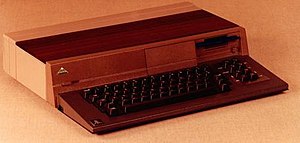Atari Sierra

The only known image of the Sierra mock-up. It looks similar to the Amiga 1000 but has an attached keyboard and an Atari-style joystick port can be seen on the left.
|
|
| Also known as | Rainbow |
|---|---|
| Developer | Atari |
| Type | 16-bit/32-bit personal computer |
| Release date | Prototype 1983 |
Sierra was the code name for a 16-bit/32-bit personal computer designed by Atari's Sunnyvale Research Lab (SRL) starting around 1983. The design included a new GPU known as "Silver and Gold", a powerful sound synthesizer known as AMY, and a new operating system code-named "Eva". The two-chip GPU was collectively known as Rainbow, and the system is sometimes referred to by this name. The CPU had not been chosen, but the Motorola 68000 and Intel 286 were being considered.
Sierra was one of several similar machines being designed at the same time by different departments within Atari, and at external contractors like Amiga. At least three such designs are known to have been worked on. All of them were slowed by corporate indecision about how such a machine would be positioned in the market; as a games machine, home computer or even a workstation. Atari eventually chose Amiga's design, only to have it purchased out from under them by Commodore International.
Sierra was still a paper project when the company was purchased by Jack Tramiel in July 1984 and the majority of SRL was laid off. Only the synthesizer had progressed very far at this point, and was produced in small numbers as the Atari AMY.
Atari's earlier consoles and computers generally used an off-the-shelf 8-bit central processor with custom chips to improve performance and capabilities. With most designs of the era, graphics, sound and similar tasks would normally be handled by the main CPU, and converted to output using relatively simple analog-to-digital converters. Offloading these duties to the custom chips allowed the CPU in Atari's design to spend less time on housekeeping chores. Atari referred to these chips as co-processors, sharing the main memory to communicate instructions and data. In modern terminology, these would be known as integrated graphics and sound, now a common solution for mainstream offerings.
...
Wikipedia
